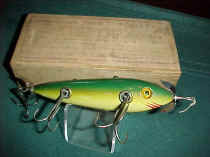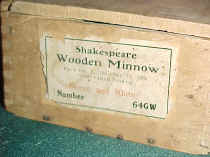|
Slide top wooden boxes like these actually came after some of Shakespeare's early cardboard Wooden Minnow boxes. But they're a strong favorite among collectors, and they date to around 1910. The 5-hook minnow inside is in a goldish aluminum finish and has neat hand-painted gills. |
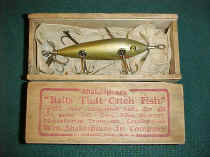 |
|
Slide top wooden boxes also were made in a much smaller size to accommodate the Baby Revolution baits and the wonderful little Shakespeare 03 minnows like the one shown to the right. Although rarer, the smaller wooden boxes don't command the collector interest as the large ones do. This all red lure is unfished and has yellow hand-painted gills. |
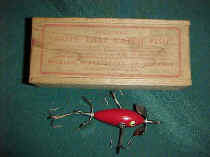 |
|
The Shakespeare Revolution Bait came out around 1900. This introductory box is one of the most sought after by collectors everywhere. The lure is mint and the flyer inside advertises a fishing contest, in which whoever catches the largest bass on the new Revolution bait will receive a silver reel valued at $15. The deadline for entering the contest is Fall 1901. The slightly different box shown below, without papers, was acquired from a visitor to this website. |
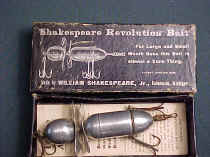 |
|
The painted rubber Shakespeare Sure Lure Bait is another lure that emerged shortly after 1900, and which came in the rare black introductory picture box. This lure is unfished and somehow survived nearly a century of existence, but the rubber body cracked and had to be carefully reglued. |
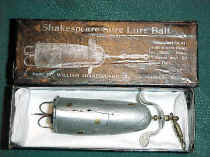 |
The earliest Shakespeare Wooden Minnow lures had the unusual "longhorn" props, shown here, and the shapely "hi-forehead" body. Note the milky glass eyes, which date this bait to around 1904. The box correctly says No. 1622, 3 hooks, red back/yellow belly. This Shakespeare Wooden Minnow has been owned by two dear friends over the years and, for that reason alone, is one of the favorites of this collection. The paperwork mentions the Rhodes Frog and other early classics. |
|
The next series of Shakespeare Wooden Minnow lures had the "hump" propeller, seen here on this gorgeous No. 44 five-hook minnow. The maroon picture boxes of this era could have white, yellow or green paper labels. This box carried the Shakespeare or Rhodes 1901 and 1904 patent dates and numbers, but I would date this combo to the 1906-1909 era. This bait was found in Missouri. |
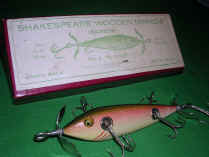 |
|
The Rhodes Wooden Minnow was a cheaper line of underwater minnows, but they are very desirable to collectors due to their connection with F.D. Rhodes, another important lure maker from Kalamazoo. This mint-in-box Rhodes Wooden Minnow, dating to around 1906, was found in Florida. Notice the beautiful blended paint finish, and the round body, which differed from the tapered bodies on Shakespeare's premium underwater minnows. |
 |
|
This is the 5-hook version of the Rhodes Wooden Minnow shown above. Although this lure has a rainbow-like blended paint finish, many Rhodes wooden minnow lures have vertical "hash marks" on either side of the lure. Rhodes Wooden Minnow lures have rounded props while the more expensive models labeled as "Shakespeare wooden minnows" have pointed props and hand painted gill marks. This box came from a basement in Michigan. |
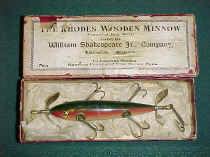 |
The Shakespeare Worden Bucktail Spinner lure dates to around 1903 or thereabouts and is a companion of the Revolution bait. It is named for the founder of the South Bend Bait Company, F.G. Worden, who apparently was a contemporary and fishing companion of William Shakespeare. Any Shakespeare Worden Bucktail boxe is a rare find. |
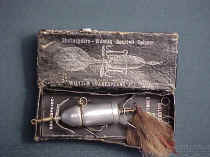 |
The Rhodes Mechanical Swimming Frog is made of rubber and designed so the legs kick as the line tie is pulled. These rare classics are usually found in a wooden box. This example is in a very unusual gray cardboard box that is seldom seen. This beautiful Rhodes Mechanical Swimming Frog was found in a closet in an old home in Arizonan - and acquired from a visitor to this website. Could you imagine fishing with this? |
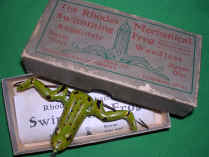 |
Mounted in the belly of the Rhodes Mechanical Swimming Frog was an oval-shaped lead weight to give the lure balance. The back of the lure has a handsome hand-painted frog finish while the underside is a flat aluminum color. The staple rig molded into the chin on the lure's underside was made to attach a double hook if the angler so desired. The paperwork described the Rhodes Mechanical Swimming Frog and other lures of the pre-1910 period. |
 |
Here is another Rhodes Mechanical Swimming Frog in the traditional wooden slide-top picture box. This luscious specimen came from a gentleman in Washington State whose grandfather lived and fished in Missouri in the early part of the century. The Rhodes Mechanical Swimming Frog box is unusually large for the lure that went inside. Some people think Shakespeare used eyeglass boxes made for other products. Note this frog's hand-painted red eyebrows. |
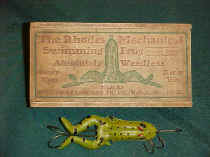 |
This is the rare Shakespeare Tournament Casting Frog, listed in catalogs around 1901-1902. The Shakespeare Tournament Frog wasn't a lure at all, but rather a casting weight made from hard rubber that included a lead weight inside the belly that protrudes like a little club from the frog's crotch. The Shakespeare Tournament Casting Frog is one of the hardest frog lures to find. They are hand painted. |
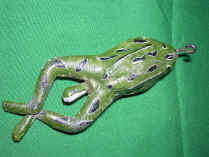 |
This is one of the rarest lures of all times: a mint-in-box Shakespeare Musky Minnow, circa 1909-1911. Note the huge glass eyes, inch-long hand painted gills and extra large, strong hooks. This specimen was acquired from a visitor to this website; it sat unnoticed and unappreciated in a Missouri basement for many decades. All Shakespeare Wooden Minnow lures are rare in musky size. |
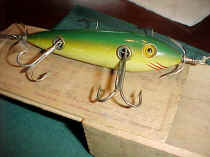 |
Here is the same huge Shakespeare wooden minnow photographed beside a standard three-hook underwater bait from the same era. These musky minnows had multiple lead belly weights and were mainly used for trolling, as their mass and weight would make them almost impossible to cast. Below are more views of this fabulous lure and eight-inch-long wooden box! Hope you enjoy them. Not many of these around. |
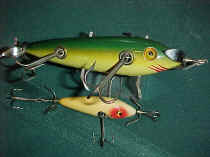 |
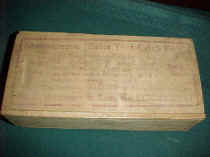 |
